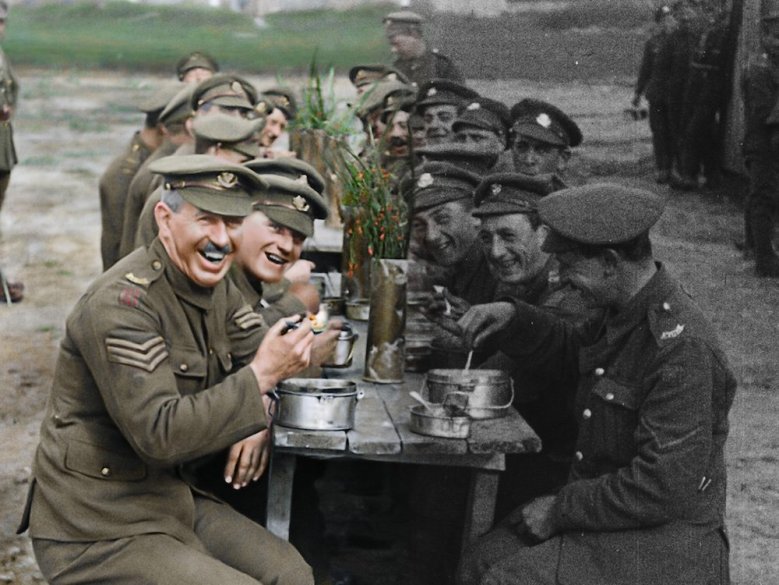Gallery with alias: PUBLIC_HISTORY_BLOG_POSTS not found

The last time I checked, I owned the films that we’re in the process of colorizing.
I can do whatever I want with them, and if they’re going to be shown on television, they’re going to be in color.
~ Ted Turner
More than thirty years ago media mogul Ted Turner purchased the rights to a massive MGM classic film collection, paying $1.2 billion for 3,650 titles. Such an investment shouldn’t be sitting unseen in a vault, so Turner turned to television as a platform to show–and monetize–his films. But to do so, he reasoned, the old black and white creations needed to be more appealing to modern audiences–and advertisers. Marketing research at the time showed that advertising revenue for black-and-white films was far lower than color films.
So to Turner, the colorizing of his films was a business opportunity. He wasn’t too concerned about preserving the historical aesthetic originality of the archive. Turner was quoted in the LA Times as saying:
I’m really shocked at the fuss. I personally don’t think it makes that much difference in the end. I think editing these movies makes a hell of a lot more difference in how they look, especially when they’re chopped up by 20 or more minutes in order to fit into the time slots. Why aren’t people making a fuss about that? Besides, I like things in color. We see in color. Why didn’t they [filmmakers protesting Turner’s colorization efforts] make ‘The Sting’ in black- and-white if they’re so concerned about historical authenticity? I don’t see their point.
Turner was defiant against the critics; he’s quoted as saying, “I’m colorizing Casablanca just for controversy’s sake. Once people start watching the colored version, they won’t bother with the original.”
The ethical concerns surrounding the colorizing of old film and photographs is something public historians should weigh in on. After all, these media are representations of the past through the technological capture of sights and sounds. What did life look like back in the 1920s? We can turn to the movies to help us understand. When synchronized sound was added to film in the 1930s (actually the first known publicly shown sound films took place around 1900), another window into history opened up for us.
From a social science perspective, film making since “the talkies” began in the 1930s has served to give us the most dynamic, 3-dimensional record of the sights and sounds of humanity imaginable. What did life realistically look and sound like during World War 2? Let’s turn to the film archive.
Of course, life has been captured through media long before the 1930s, but the further we go back in time the more problematic these historical artifacts become in terms of visual and aural fidelity. The quality of recording technology has been steadily improving since the first photograph (Niépce’s estatein Le Gras, c. 1823), recorded sound (Au clair de la lune, 1860), and first known motion picture (Roundhay Garden Scene, 1888).
With some exceptions, it’s fair to say that up until the 1930s the collective media archive contains mostly scratchy, crackling, faded, fragile, fuzzy, or otherwise barely intelligible representations of life. Advances in visual media (photos and film) seems to have improved faster than sound media, but the two technologies have actually advanced together. In fact, the silent film era of the 1920s didn’t have to be silent. The technology of synchronized sound existed at the time, but it was not considered economically or aesthetically justified by film studio executives.
Before sychronized sound embedded musical scoring, dialogue, and sound effects into film, the visual had no corresponding audio unless it was accompanied by live sound production (i.e., a piano, orchestra, staged voice over parts, and ambient or environmental sound effects such as a gun shot or train whistle). Interestingly, the modern sound effects industry (today what we call Foley work) so crucial to film was born out of the 1920s radio drama era.
Today, nearly all film (and video) uses added sound effects; highly technical and artistic Foley work is omnipresent and critical in creating visual/aural 3-dimensionality in film and other media.
Turning back to history, current advances in media technology are spawning a second look at old films, photographs, and sound recordings. The colorization movement started by Ted Turner has opened a wide range of other adaptive media efforts focused on more than turning monochrome to color. Just a few decades ago colorizing media was a laborious and mostly manual process. Sometimes it was clunky and crude. Today, as older media is rendered into digital formats, computerization allows for more accurate and realistic results–for the most part.
Take for example this silent, black and white film footage of street life in 1911 New York City. Shot by the Swedish production company, Svenska Biografteatern, this film existed only in its original state until media creators Guy Jones and Denis Shiryaev started to tinker with the footage in ways that only modern digital technology can process. The result? IFLScience! website says the colorized and upscaled film using artificial intelligence (AI) is “astonishing” and “needs to be seen to be believed.”
But as one online commentor remarked:
I assume “needs to be seen to be believed” refers to how badly this actually works? Without good reference material to learn on, these AIs produce terrible results, adding more artifacts and materials constantly changing colors from sepia to pale ink blue and back. Have a Look at Peter Jacksons “And they shall not grow old”to see great colorized footage from that era.
To judge for yourself, here are differently altered versions of the 1911 NYC street footage. Which is most historically accurate, aesthetically appealing, and/or fascinating?
ORIGINAL FILM WITH MUSICAL SCORE ADDED (ERA APPROXIMATED)
ORIGINAL FILM WITH MUSICAL SCORE ADDED (MODERN)
SPEED CORRECTED WITH RECREATED ENVIRONMENTAL SOUNDS OF THE ERA
COLORIZATION WITH RECREATED ENVIRONMENTAL SOUNDS OF THE ERA
As Ted Turner realized, people have strong opinions about “messing” with these old recordings. Overall, we learned how deeply people abide by originalism. Terms such as, corlorized, digitally remastered, restored, or enhanced, or now in HD tend to flags concerns that the original quality has been compromised. And this is sometimes true, especially when older media has been processed in the hands of less skilled technicians.
But new renderings of old media are sometimes remarkably well done technically, artistically, and historically. What’s the harm in improving the quality of a film, photograph, or sound recording?
This question should be of critical importance to public historians, especially in the age of digital media.
By definition anything altered from its original state is no longer the same; originality has been lost. In altering media, the question becomes to what degree does a photograph, sound recording, or film no longer represent the original? Some might say that any changes to form or content creates something that should be clearly marked as less than true, accurate, or faithful. Others might say that the significance of alterations is just a matter degree.
Ted Turner pointed out that simply colorizing a film is not the same thing as editing it (e.g., cutting or inserting scenes, replacing dialogue, or altering the sound design including Foley effects). Everybody calm down, he urged, we still have the original.
This debate is worth having, but it bears repeating that by definition anything altered from its original state is no longer the same. Originality is lost. The primary is not the same as the secondary, the copy, or the facsimile. Sure, but again to what degree should this concern public historians? Is it their responsibility to annotate such altered renderings or derivative works that they are not original. Yes. Can public historians find practical usefulness in presenting aesthetically enhanced media in their work? Yes.
In Turner’s rationale for altering his old films, he cited that marketing data reveal that color films on television generate more advertising revenue than black and white. Translation: color films entice and inspire more people to tune in, watch, and take an interest. In short, enhanced media is more appealing to modern audiences.
For public historians looking for ways to entice and inspire people to toward their programming, exhibits, or artifacts is there an object lesson here in leveraging the power of aesthetics toward these goals?

OUR POSITION
Public historians should always research, document, and annotate original/source media
Use altered or enhanced media with caution and anticipate how people might confuse these artifact with the originals
Not all alterations are acceptable in terms of quality or historical appropriateness – use descretion
PUBLIC HISTORY MATTERS
At The Social Voice Project, we celebrate history and people through our community oral history projects that give us a chance to look, listen, and record the voices and stories of our time. We encourage all local historical societies and museums to capture, preserve, and share their communities’ lived experiences, memories, customs, and values. Future generations are depending on it.
Contact TSVP to learn more about our commitment to public history and community oral history projects.


You must be logged in to post a comment.